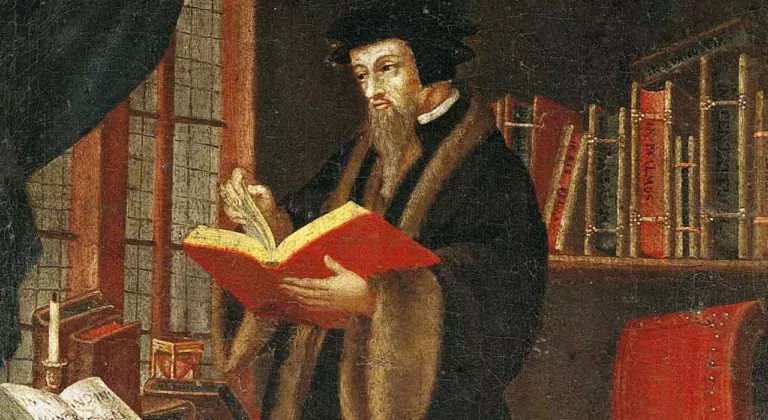A “magnum opus” is an author’s greatest work. When it comes to John Calvin his Institutes of the Christian Religion is one of the classics of Protestant theology. However, as often as it is referenced, it is seldom read as a complete work from front to back. I first purchased my copy of the McNeill/Battles edition before starting pre-seminary studies in university, more than twenty years ago. Over the years I have read bits and pieces and there, often as a need or interest required but it wasn’t until this past year that I finally read the Institutes from beginning to end.
In this essay, I will share some of the highlights of my complete tour through this theological masterpiece, and those highlights will include both points of appreciation and critique. I read the two-volume McNeill/Battles edition published in the Library of Christian Classics. This edition is based on the final version Calvin published in 1559. I also occasionally referred to the older editions of Beveridge and Allen, and even sometimes checked the original French and Latin.
Different translations and editions
Calvin originally wrote the Institutes in 1536 as a sort of catechetical handbook. It was never designed to be a systematic theology – such a creature did not yet exist. It was also not designed to be a book of extensive commentary on Scripture. No, its original purpose was catechetical – to summarize the teaching of Scripture on essential matters of faith and life.
However, as the work progressed to its final form in 1559 – twenty-three years later – it did take on a more systematic form. In some places there is limited commentary on Scripture – for example, when dealing with the Ten Commandments (2.9) or the Lord’s Prayer (3.20.34-49) – and there are extensive references to Scripture, but generally Calvin leaves biblical exposition to his commentaries.
A Scriptural foundation…most of the time
His approach is typically theological, with the Scriptures explicitly as a foundation. However, by way of exception, there are parts that are more philosophical. For example, in 1.15.6-8, Calvin discusses the soul. There is almost nothing directly from Scripture in this discussion. Instead, Calvin works more with philosophical ideas from the likes of Plato. For a modern reader unfamiliar with Greek philosophy, this discussion is difficult to follow.
Related to that, there are places where Calvin follows Platonic notions instead of biblical ones. One of the most well-known examples is how Calvin speaks of the body as the prison house of the soul. He does this in at least four places (1.15.2, 2.7.13, 3.7.5, 3.9.4). This devaluing of the body does not accord with the biblical worldview. In Scripture, the body is redeemed by Christ just as well as the soul (1 Cor. 6:19-20), and will be raised at the last day (1 Cor. 15).
Well-read and it shows
The attentive reader will pick up on Calvin’s copiousness – he read widely! Throughout the Institutes, Calvin refers to numerous authors going all the way back to the early church. Two stand out in particular.
The most quoted and referred to author is Augustine. This is not surprising since Augustine is the most influential of the church fathers on the Protestant Reformers in general. Most of the time Calvin quotes Augustine approvingly, but there are also occasions where he dissents.
The other author is Bernard of Clairvaux, a Cistercian monk who lived from 1090 to 1153. While Bernard lived before the worst developments in Catholic theology, he was still not exactly a medieval quasi-Protestant. Nevertheless, Calvin made use of Bernard’s best insights. In 2.16.1, Calvin gives this beautiful quote from Bernard’s Sermons on the Song of Songs:
The name of Jesus is not only light, but also food; it is also oil, without which all food of the soul is dry; it is salt, without whose seasoning whatever is set before us is insipid; finally, it is honey in the mouth, melody in the ear, rejoicing in the heart, and at the same time medicine. Every discourse in which his name is not spoken is without savor.
Calvin appreciated Bernard’s fervor for Christ and his felicitous turn of phrase.
Brilliant, but also inexplicable, word choices
Calvin likewise employed language with a skilled eye to felicity. Calvin valued beautiful rhetoric – throughout the Institutes there are words so well crafted you may feel some salty moisture rolling down your cheek. Calvin’s Institutes feature numerous sections like this in 3.2.42:
Accordingly, in brief, hope is nothing else than the expectation of those things which faith has believed to have been truly promised by God. Thus, faith believes God to be true, hope awaits the time when his truth shall be manifested; faith believes that he is our Father, hope anticipates that he will ever show himself to be a Father toward us; faith believes that eternal life has been given to us, hope anticipates that it will some time be revealed; faith is the foundation upon which hope rests, hope nourishes and sustains faith.
Calvin was indubitably a master of using language to powerful effect.
Regrettably, I have to say I also encountered instances where Calvin uses strong, questionable, or even offensive language. He uses strong language when it comes to unbiblical and dangerous ideas. But he also uses strong words for the person of his theological opponents: “blockheads” (3.20.25), “stupid men” (3.21.7), “swine” (3.23.12), and many other such insults. I have read enough Reformation literature to know Calvin was not unusual in using this kind of language – and our day tends to be far more sensitive about throwing invectives around in our theological polemics.
I am far less inclined to give Calvin a pass on some other language he uses. In three places, Calvin uses the exclamation “Good God!” (3.4.29, 3.4.39, 4.16.27). In each context, it is clearly an exclamation and not a sincerely-meant prayer to God. The expression was used in Calvin’s original Latin of the 1559 edition (“Bone Deus!”), but for some reason he dropped it in the French. In each instance, the older translations of Beveridge and Allen omit these exclamations. I have encountered the same expression in the writings of Guido de Brès.
I find it troubling and I cannot find a way to excuse it. I would suppose that, being former Roman Catholics, they became accustomed to using this exclamation to express great horror – a blind spot.
Challenges and benefits
For readers today there are some challenges in reading and benefiting from Calvin’s Institutes. Some of the discussion has less relevance to us. For example, I found the discussion about the sacramental theology of the Roman Catholic Church to be one of the most tedious parts of the work. It may be interesting from a historical standpoint, and it might still be valuable to someone actively engaged in apologetics with Roman Catholics, but for the rest of us, the temptation to skip through this section is difficult to resist.
Persevering readers will encounter some of Calvin’s best and most well-known theological insights. Among them:
- The Scriptures serve as spectacles to help us see God clearly (1.6.1, 1.14.1)
- “…man’s nature, so to speak, is a perpetual factory of idols (1.11.8)
- Calvin believes the world to be less than 6000 years old (1.14.1, 3.21.4)
- Justification “is the main hinge on which religion turns.” (3.11.1)
- Fasting “is an excellent aid for believers today (as it always was)…” (4.12.18)
- If baptism is to be denied to the infant children of believers because Scripture is silent on the explicit practice, then women should also be denied access to the Lord’s Supper (4.16.8)
- The Lord’s Supper should be celebrated frequently, preferably every week (4.17.43)
- Aristocracy, or perhaps a system compounded of aristocracy and democracy “far excels” all other systems of government (4.20.8)
- Revolts are possible when led by lower magistrates (4.20.30)
Reading Calvin’s Institutes will remind Reformed believers today that Calvin is not the gold standard for what it means to be Reformed. After all, there are several points at which much contemporary Reformed faith and practice departs from Calvin. For example, in 4.3.16, he discusses the laying on of hands in connection with office bearers. He argued that this laying on of hands ought to be practiced not only with the ordination of “pastors and teachers,” but also deacons. Interestingly, the original Belgic Confession also said that all office bearers should be ordained with the laying on of hands. While there are Reformed churches which follow Calvin on this, there are also those (like the Canadian Reformed Churches and the Free Reformed Churches of Australia) which do not involve the laying on of hands in the ordination of elders or deacons.
Conclusion
Let me conclude with noting that the McNeill/Battles edition is generally well-done. There are comprehensive indices. There are immense numbers of helpful explanatory footnotes.
It must be said, however, that some of these footnotes reflect the editor’s liberal theological bias. For example, in a footnote in 1.8.8, the editor informs us that Calvin did not hold to the modern view of a late date for Isaiah 45 and its mention of Cyrus. Well, I guess not, seeing as how Calvin believed the Bible to be the Word of God!
As another example, in a footnote in 4.8.9, the editor claims Calvin does not explicitly support biblical inerrancy anywhere. While it would obviously be anachronistic to expect Calvin to affirm every jot and tittle of the Chicago Statement on Biblical Inerrancy (written in 1978) there is plenty of evidence to affirm Calvin has far more in common with biblical inerrantists today than their opponents.
For most Reformed people today, Calvin’s Institutes will remain a reference. No one should expect regular church members to pick it up and read it straight through with profit. Those who try will almost certainly get frustrated and give up. We must be realistic. It is a work from an era in which theologians could expect far more from their readers. I wonder whether even many of today’s pastors would be able to digest everything Calvin serves up. Some of his discussions and references certainly went beyond my ken. We live in a strange time where we have more access to information than anyone else in the history of world, and yet, compared to Calvin from 500 years ago, we are dullards. Reading through the Institutes certainly drove that point home to me.
Dr. Bredenhof blogs at Yinkahdinay.Wordpress.com where this article first appeared.











